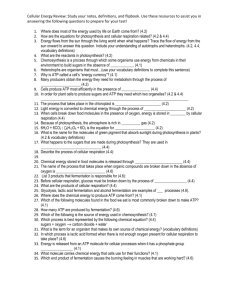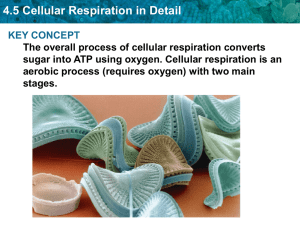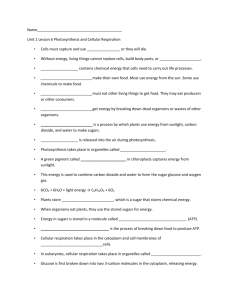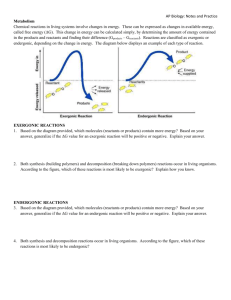UNIT 5 NOTES – ENERGY PROCESSES METABOLISM Metabolism
advertisement
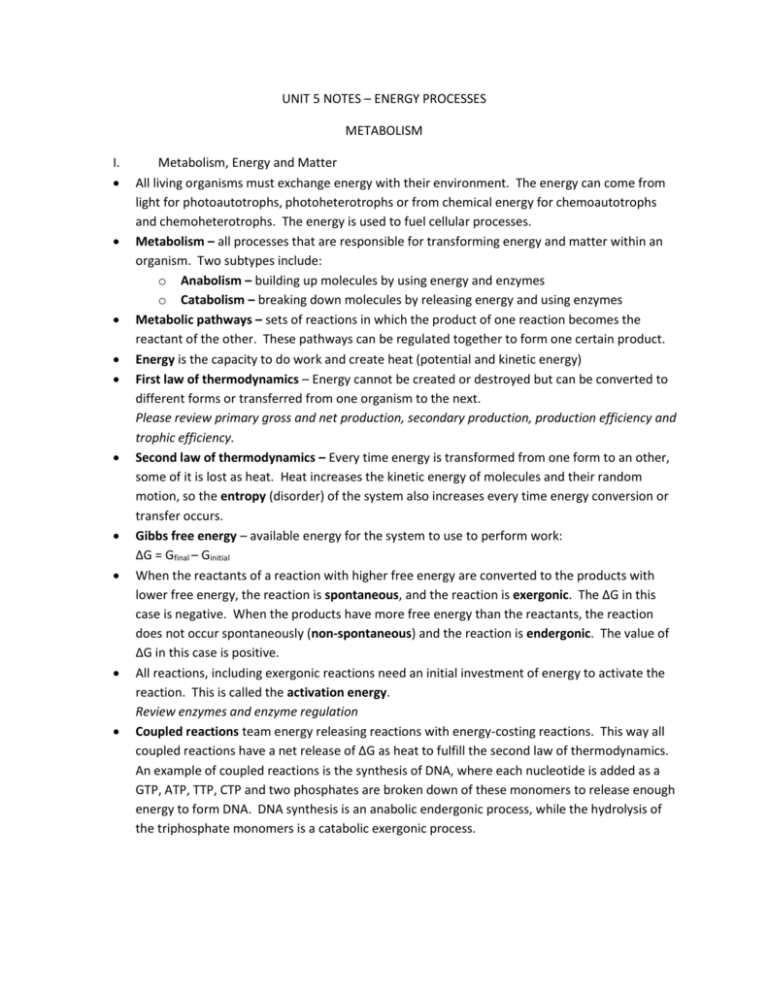
UNIT 5 NOTES – ENERGY PROCESSES METABOLISM I. Metabolism, Energy and Matter All living organisms must exchange energy with their environment. The energy can come from light for photoautotrophs, photoheterotrophs or from chemical energy for chemoautotrophs and chemoheterotrophs. The energy is used to fuel cellular processes. Metabolism – all processes that are responsible for transforming energy and matter within an organism. Two subtypes include: o Anabolism – building up molecules by using energy and enzymes o Catabolism – breaking down molecules by releasing energy and using enzymes Metabolic pathways – sets of reactions in which the product of one reaction becomes the reactant of the other. These pathways can be regulated together to form one certain product. Energy is the capacity to do work and create heat (potential and kinetic energy) First law of thermodynamics – Energy cannot be created or destroyed but can be converted to different forms or transferred from one organism to the next. Please review primary gross and net production, secondary production, production efficiency and trophic efficiency. Second law of thermodynamics – Every time energy is transformed from one form to an other, some of it is lost as heat. Heat increases the kinetic energy of molecules and their random motion, so the entropy (disorder) of the system also increases every time energy conversion or transfer occurs. Gibbs free energy – available energy for the system to use to perform work: ΔG = Gfinal – Ginitial When the reactants of a reaction with higher free energy are converted to the products with lower free energy, the reaction is spontaneous, and the reaction is exergonic. The ΔG in this case is negative. When the products have more free energy than the reactants, the reaction does not occur spontaneously (non-spontaneous) and the reaction is endergonic. The value of ΔG in this case is positive. All reactions, including exergonic reactions need an initial investment of energy to activate the reaction. This is called the activation energy. Review enzymes and enzyme regulation Coupled reactions team energy releasing reactions with energy-costing reactions. This way all coupled reactions have a net release of ΔG as heat to fulfill the second law of thermodynamics. An example of coupled reactions is the synthesis of DNA, where each nucleotide is added as a GTP, ATP, TTP, CTP and two phosphates are broken down of these monomers to release enough energy to form DNA. DNA synthesis is an anabolic endergonic process, while the hydrolysis of the triphosphate monomers is a catabolic exergonic process. II. ATP Is The Main Energy Currency in Cells Most cellular work is directly fuelled by the hydrolysis of one simple molecule, called adenosine triphosphate, ATP. The cell uses various molecules to store energy (such as starch, glycogen, proteins, simple lipids) but for direct energy use the cell mostly uses ATP. (Incorrectly stated in the book) The structure of ATP is made up of: o Adenine o Ribose o 3 phosphates ATP can break down into adenosine diphosphate (ADP) by hydrolysis in an exergonic reaction and releases energy for cells to use. Also, the phosphate released can bind with other molecules and energize them by changing their shape – Phosphorylation. The energy released is sufficient enough to fuel other endergonic processes. ADP can also be refueled by using exergonic reactions that will phosphorylate it to form ATP again. This way the cell regenerates ATP by using exergonic reactions such as cellular respiration. Because ATP is universally used by all living organisms, it must have evolved early on and is an indicator of the common origin of life. Other energy carrying molecules are also used by cells, such as GTP, NAD+, FAD, NADP+ and others. ENERGY TRANSFER I. Energy In Living Systems The chart below says it all: General equations also show the interrelatedness of photosynthesis and cellular respiration. II. Overview of Cellular Respiration The main purpose of cellular respiration is to release energy from organic molecules by breaking these down to simple carrier molecules than eventually to ATP. Cellular respiration can be aerobic – requires oxygen or anaerobic – does not require oxygen. In the case of anaerobic pathway an alternative process called fermentation completes the process. An aerobic or an anaerobic version of cellular respiration takes place in all living organisms. Cellular respiration can break down glucose directly, but can also metabolize any other organic molecule that is used as an energy source (anything except nucleic acids). Fat molecules produce the most ATP /g of molecule, more than carbohydrates or proteins. Cellular respiration is the step by step oxidation of glucose. This process takes place in small steps to minimize the loss of heat in the process and maximize the efficiency. The overall equation that only shows the starting and end products is: C6H12O6 + 6O2 --- 6CO2 + 6H2O + energy (in the form of ATP and heat) Because this process is exergonic, it releases heat, so ΔG is negative. The entire process of cellular respiration is broken down to small steps of redox reactions. In a redox reaction, two steps occur at the same time. One of the reactants is reduced, meaning gains electrons (may be visible as a gain of hydrogen ions) while the other reactant is oxidized because it loses electrons (may be visible as losing hydrogen ions). (“LEO the lion goes GER”) In general, reduced forms of substances have more energy than the oxidized forms of the same substances. III. Mobile Carriers As a series of redox reactions take place in cellular respiration, electrons are moved along and their energy is gradually released. Because these electrons are not transferred directly from glucose (oxidized) to oxygen (reduced), electron carriers are required to move the electrons along. NAD+ is the most versatile carrier that picks up 2e- and 1H+ and carries them to the last step, oxidative phosphorylation where it is going to be oxidized back to its empty form. NAD+ + 2 e- + H+ NADH Another electron carrier is FAD, which is used only in the citric acid cycle and also carries electrons to oxidative phosphorylation: FAD + 2e_ + 2H+ Prezi link: http://prezi.com/m9s0caebmwdu/ap-bio-energy-3-chemoheterotrophic-nutrition/


